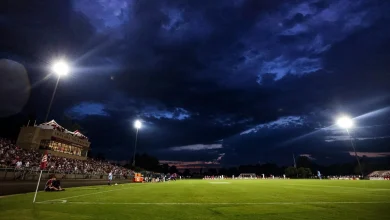How a recruiting philosophy switch lifted Purdue basketball to national championship path

WEST LAFAYETTE — Purdue men’s basketball’s coaching staff came together for a pivotal debate in the fall of 2022.
The question on the table was whether freshmen Braden Smith or Fletcher Loyer would open the season in the starting lineup. The resolution of the conversation remains an inflection point in Boilermaker history.
“I just let them talk – they all gave their two cents or whatever,” coach Matt Painter said. “And I just said, ‘Those two guys are gonna take us to a Final Four.’”
That prediction came true two years later. That decision, and the decision one year earlier to hold Trey Kaufman-Renn back with a redshirt season, set in motion one of the more anticipated seasons in the program’s lifespan.
Purdue opens the season ranked No. 1 in both polls and as the betting favorite to win the national championship. Those expectations reflect both the roster’s championship DNA, accumulated over three years of triumph and trials, and its ongoing evolution.
Looking back over the past 15 NCAA tournament champions, some areas of Purdue’s known talents strongly correlate. In other areas, the Boilermakers’ best basketball must find their way to a better version of themselves in the next six months.
How Matt Painter changed recruiting philosophy to improve Purdue basketball offensive efficiency
As much as Purdue embraces a blue collar, “Play Hard” identity, history says national champions don’t win ugly in abundance. Most nights, they either lean on opposing defenses until they break or simply blow them away.
Purdue ranked seventh in Ken Pomeroy’s adjusted offensive efficiency metric last season. Its score of 124.6 ranked higher than 11 of the last 15 national champions.
For all intents and purposes, the program ended last season with a national championship-caliber offense. All of the players most responsible for that pristine production returned. Smith enters the season with the all-time assists record in reach. Kaufman-Renn, playing most of last season as an undersized center, became one of the country’s most efficient low-post scorers.
Yet the origins of that identity trace back far before last season — even farther than Painter’s premonition about Smith and Loyer. Go back 12 years, after a run of six straight tournament appearances, when Purdue posted back-to-back losing seasons. Painter made a conscious choice to change the makeup of his roster.
“I really was recruiting off of stats, to be honest with you,” Painter said.
He looked for players who shot better than 40% from 3-point range and 80% at the free throw line and with at least a 2-to-1 assist-turnover ratio. For a while, that led to a wing-heavy guard contingent and too few ball handlers who could break down opposing defenders.
Last season, Smith, Loyer, C.J. Cox and Gicarri Harris combined to shoot 39.37% from 3 and 83.87% from the line with a 2.32 assist-turnover ratio.
So why did Purdue go out and add another lead guard in the spring?
Omer Mayer was a late arrival this summer after playing for Israel in multiple international tournaments. He’s a taller, stouter complement to Smith. He averaged 17.9 points and 4.8 assists over those 11 FIBA games, showing he could go get buckets and open them up for others.
The roster obviously already has one of those, and some other guys who can bring the ball up if Smith needs a break or requires one due to fouls.
Adding Mayer to the mix, though, was not merely a luxury. In the final game of the season, Houston forced Smith to give up the ball. It led to 15 assists but only a 2-for-7 shooting night.
Mayer came in as the counterpunch to that approach.
“Having multiple creators is important,” said P.J. Thompson, the former Purdue point guard now coordinating the offense. “I don’t think we can win a national championship when Braden is our only creator. I don’t. And I think last year, we were in that box.
“For how we played last year, I don’t think (Smith) could have been better. I thought we were awesome after losing the generational talent. But it still wasn’t enough. Our goals aren’t Sweet 16s.”
Purdue can play even more efficiently this season. Cox and Harris are no longer freshmen feeling their way through the Big Ten. Thompson said he trimmed back the play book some to simply a complicated system. A major regression seems unlikely, and statistically, there’s not much room for improvement there.
On the other end of the floor, however …
Purdue basketball defensive efficiency hinges on Braden Smith, Trey Kaufman-Renn, Fletcher Loyer defending better
Compare where Purdue ended last season to the past 15 champions and another metric sticks out like a red sweater in the Paint Crew.
One might assume well-oiled offenses bought those championship teams some slack on defense. On the contrary, the numbers pretty convincingly say you need both.
Again using KenPom, the lowest adjusted defensive efficiency among the last 15 champions was Villanova’s 94 in 2018. That still ranked 11th nationally. Most champions finished the season somewhere in the low 90s. None ranked lower than 22nd nationally, and 12 ranked in the top 11.
Maybe defense doesn’t win championships, but champions who don’t play great defense are the exception to the rule.
Purdue’s adjusted defensive efficiency of 99.2 last season ranked 53rd. That wasn’t far off from Final Four caliber, as it turned out. Yet it also meant volatile performances and vulnerability when shots didn’t fall on a given night.
The Boilermakers needed to get better, but they also needed to get luckier.
Daniel Jacobsen showed up as a 7-foot-4 heir to the Zach Edey big man spotlight. He won a starting lineup spot to open the season, blocked three shots in his first game and broke a leg bone one minute into his second.
Elite rim protection is not mandatory for championship hopes. Those past 15 champions included only one leader in block percentage — Kentucky’s Anthony Davis-led 2012 team — and six in the top 50. However, some rim protection appears to be critical, as each of those champions recorded at least a 9% block percentage.
Without Jacobsen, Purdue plummeted to 5.1%, 358th nationally. He and South Dakota State transfer Oscar Cluff (second in the Summit League in block percentage last season) now trade off providing an essential defensive backbone.
“I think I’ve picked up a lot of stuff just from watching and learning, watching film,” Jacobsen said. “The time in the weight room, it’s just made me stronger and more athletic, and I’ve been able to get off the ground a little faster.”
Purdue did not merely miss the shots Jacobsen didn’t block. The perimeter defenders missed the security blanket he provided behind them.
They have it now, and it must be a factor in the whole group’s defensive improvement.
When Painter shifted his recruiting focus to offensive skill, it came with a decrease in recruiting two-way players. The hope was elite offensive efficiency would help offset that lack of guarding talent by allowing Purdue to more consistently set its defense — and thereby the terms on which opponents would attack.
It’s a sound hypothesis — if Smith, Loyer and Kaufman-Renn play the best defense of their careers.
“You can’t be a great defensive team if the players that play the most aren’t great defensive players,” Painter said. “What we need more than anything is those seniors that play the most to be better on the defensive end.”
How Purdue basketball desparately tried to improve its rebounding
Between the first weekend of the NCAA tournament in Providence, Rhode Island, and the regional round in Indianapolis, Painter snuck in a visit to South Dakota.
The modern college basketball roster building calendar does not pause for the Sweet 16. Painter coached a team that did not rebound well enough, and when he looked six months into the future, he saw the same.
“We needed to rebound,” Painter said. “We had to go get Oscar. We had to. That was absolute for us.”
Championship teams tend to use rebounding as the emphatic door slam on a defensive possession or the backbreaking cancelation of another team’s defensive success, or both.
The numbers don’t correlate as directly and obviously here as they do with offensive and defensive efficiency. However, over the past 15 years, only one NCAA champion recorded a defensive rebounding percentage under 70% and an offensive rebounding percentage under 32%. That was UConn’s 2013-14 team — a 7 seed which serves as an outlier to many of these championship norms.
Purdue’s rebounding percentages last year? Only 70.3% on defense and 31.8% on offense. Close enough to championship precedent that the Boilermakers could push eventual national runner-up Houston to the brink in the Sweet 16. Yet also not special enough in either category to make up for those defensive lapses.
Painter placed the responsibility for lifting the rebounding production on the broad shoulders of a well-traveled Australian. Kaufman-Renn did his best at center last season, proclaiming himself one of the most physical players in the country, then endeavoring to live up to the title.
However, Cluff’s sheer size and leverage could not be replicated elsewhere on this roster. Purdue had to splice its natural, homegrown nucleus with this (literal) foreign body and grow something new.
“I want to fill the role they need me to fill the best that I can,” Cluff said. “I think that’s just learning over time.”
Purdue basketball has experience but needs to match championship DNA
All of the above constitute tangible, quantifiable components of basketball performance.
Can we also measure intangibles? The numbers on the correlation between experience and winning are a bit wonky. The NCAA’s expanded eligibility clock after the COVID-19 pandemic dirtied the data a bit.
A safe assumption says having more players with experience winning cannot be a bad thing. Purdue’s big three have played 10 NCAA tournament games, with seven wins. They won a Big Ten tournament championship, two regular-season championships and are 3-0 in exempt tournaments around Thanksgiving.
So, yes, Purdue returns a lot of minutes. Sixth most in the country, per Bart Torvik, and second-most when correcting to account for players with their teams’ highest usage rates. That’s a lot of championship DNA at work from opening day.
If that group completes its evolution — with the help of new blood — all of those expectations are within reach.
Nathan Baird and Sam King have the best Purdue sports coverage, and sign up for IndyStar’s Boilermakers newsletter.





